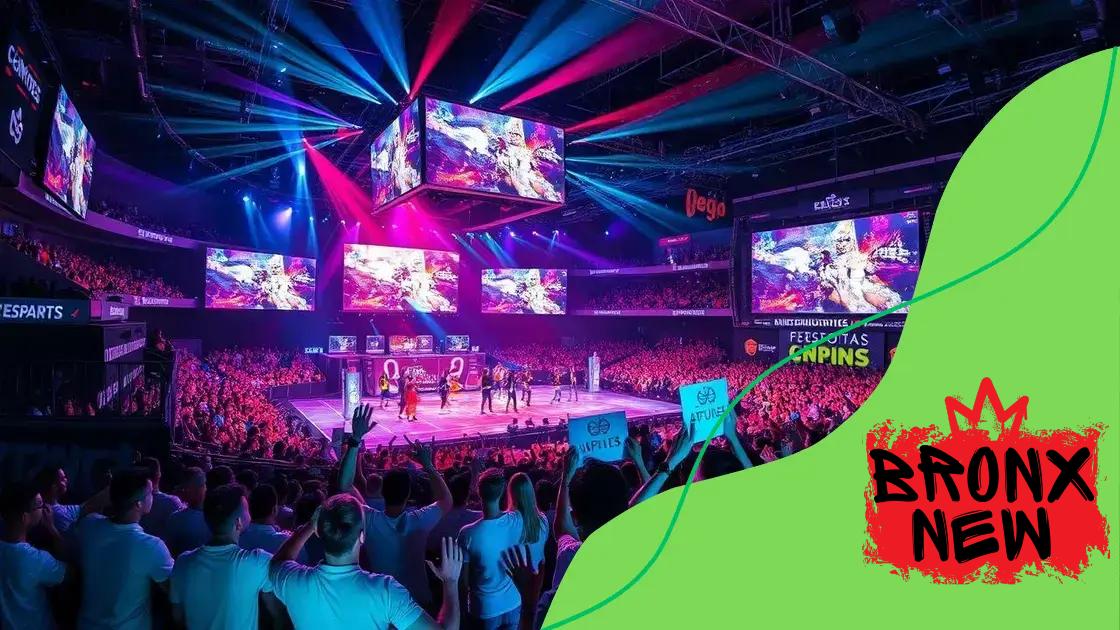How e-sports are influencing mainstream media content

How e-sports are influencing mainstream media content is evident as streaming platforms and traditional media collaborate to enhance audience engagement and provide immersive experiences for viewers.
How e-sports are influencing mainstream media content is a fascinating topic that reflects how gaming has transcended beyond just entertainment. Have you noticed how e-sports events pull in massive audiences and are reshaping entertainment industries? Let’s dive into this phenomenon.
The rise of e-sports in popular culture
The rise of e-sports in popular culture has been astonishing. What began as a niche interest is now a global phenomenon that attracts millions of fans. As more people engage with streaming platforms and online tournaments, we see e-sports entering the mainstream in exciting ways.
Changing Entertainment Landscape
With the surge of e-sports, traditional media is adapting. Streaming platforms like Twitch and YouTube Gaming have transformed how audiences consume gaming content. Viewers are no longer just passive observers; they become active participants in the gaming experience.
Key Factors Contributing to E-sports Popularity
- Increased accessibility: With the rise of high-speed internet, anyone can join in on the action.
- Celebrity endorsements: Popular athletes and celebrities are now promoting e-sports, enhancing its appeal.
- Community engagement: Players and fans form communities online, fostering a sense of belonging.
As these factors combine, e-sports continue to grow in popularity. Many games now feature competitive tournaments, with players showcasing incredible skills. Major events fill arenas and attract massive online viewership. Brands are leveraging this surge, investing in e-sports sponsorships to reach younger audiences.
Moreover, educational institutions are recognizing the value of e-sports. Some schools offer scholarships for talented players, blending sport and academics. This approach further legitimizes e-sports in society. As e-sports gain traction, it shapes discussions around competition, teamwork, and digital engagement.
In this vibrant context, the lines between gaming and traditional sports are blurring. It’s not uncommon to see a professional gamer treated with the same respect as a well-known athlete. This recognition includes not just competitive skill but also strategic gameplay, similar to what you’d find in sports like basketball or soccer.
The rise of e-sports proves that gaming is no longer confined to basements or bedrooms. It has transformed into a cultural movement, influencing everything from fashion to social interactions. As we continue this journey, it raises interesting questions about the future of media and entertainment.
How e-sports are changing media consumption habits
How e-sports are changing media consumption habits is significant in today’s digital landscape. As large tournaments and gaming events gain traction, they reshape how audiences engage with content. Viewers are shifting from traditional TV to online platforms, drawn by the excitement of live competitions.
Emergence of Streaming Platforms
With platforms like Twitch and YouTube Gaming dominating, fans have more access to content than ever. These platforms allow gamers to showcase their skills, creating an interactive experience. Audiences can chat, cheer, and even influence gameplay in real-time. This interactivity makes e-sports more appealing, drawing in viewers who crave engagement.
Changing Viewer Expectations
- Quality content: Viewers expect high production values similar to traditional sports broadcasts.
- Real-time interactions: Fans want to engage directly with their favorite players through comments and live chats.
- Diverse formats: Short highlights, long play sessions, and commentary are all popular, catering to different viewing preferences.
As the landscape of media consumption evolves, so do viewer habits. Many young adults now prioritize digital content over traditional cable TV. This shift not only reflects a preference for flexibility but also a desire for personalized experiences. The appeal of on-demand access to gaming streams ensures that audiences can enjoy their favorite content at any time.
Moreover, e-sports are attracting a younger demographic, influencing everything from marketing strategies to media partnerships. Brands see the value of connecting with these digital natives. As a result, companies increasingly sponsor players and events, seamlessly integrating their products into the gaming experience. This integration amplifies brand visibility and resonates with an engaged audience.
Social media plays an integral role in how fans consume e-sports content. Platforms like Twitter and Instagram allow players to share their achievements, further blurring the lines between entertainment, social interaction, and gaming. Fans are not just spectators; they become part of the e-sports community, creating a sense of belonging.
Collaborations between e-sports and traditional media

Collaborations between e-sports and traditional media are becoming more common. This partnership creates exciting opportunities for both industries and audiences. As e-sports gain popularity, traditional media outlets are eager to tap into this growing market to engage a younger demographic.
Television and E-sports
Television networks are starting to air e-sports competitions. This exposure helps legitimize e-sports and brings events to a wider audience. Major tournaments are often broadcast live, drawing in fans who might not typically watch gaming content. The excitement of live gaming translates well to traditional broadcasting, making it a thrilling experience for viewers.
Digital Partnerships
- Streaming events: Many prominent e-sports events are streamed live on platforms like Twitch, creating numerous partnership opportunities with media companies.
- Highlight shows: Just like sports, e-sports have highlight reels that capture the most thrilling moments of matches, available on various platforms.
- Content creation: Collaborating with content creators allows traditional media to produce engaging content that attracts e-sports fans.
The blending of e-sports and traditional media not only enhances viewership but also brings innovations in content delivery. For instance, live commentary that accompanies events creates an immersive experience. Fans can interact with the casters and discuss strategies in real-time, similar to traditional sports commentary.
Moreover, sponsors often utilize these collaborations to engage directly with the audience. Brands recognize the potential of associating themselves with popular e-sports tournaments to reach a young and diverse audience. As a result, this partnership can drive viewership and brand loyalty.
Through these collaborations, e-sports are not just seen as a niche market; they now occupy a significant space within the broader media landscape. The excitement and energy of competitive gaming resonate with viewers in ways that traditional formats may not. As this trend continues, we can expect to see even more innovative partnerships that further bridge the gap between e-sports and traditional media.
The impact of streaming platforms on e-sports coverage
The impact of streaming platforms on e-sports coverage has been transformative. Platforms like Twitch and YouTube Gaming have revolutionized how fans engage with their favorite games. This shift has opened up new viewing experiences, bringing audiences closer to the action.
Accessibility of Content
Streaming platforms provide easy access to e-sports events worldwide. Viewers can watch live tournaments from the comfort of their homes or on their mobile devices. This accessibility allows fans to connect with games they love without needing cable subscriptions. For many, streaming is a preferred way to consume content, fostering a stronger connection to the gaming community.
Real-time Interaction
- Live chats: Fans can engage in real-time discussions during streams, reacting to gameplay as it happens.
- Polls and votes: Streamers often involve their audience through interactive polls, adding a unique layer to the viewing experience.
- Player engagement: Many professional players stream their gameplay, giving fans an inside look at their strategies and personalities.
This level of interaction creates a sense of belonging among viewers. The ability to comment and engage with other fans makes watching e-sports more communal. As viewers interact with players and commentators, they feel part of the action. This shared experience enhances fan loyalty and investment in the e-sports community.
Additionally, streaming platforms support various formats, such as highlight reels and live broadcasts, catering to diverse audience preferences. Some fans enjoy dedicated game coverage, while others prefer watching casual streams. This flexibility allows viewers to choose how they engage with e-sports based on their interests.
Moreover, the partnership between e-sports and streaming services often leads to exclusive content. Many tournaments now stream directly on platforms, ensuring fans can access content they might miss elsewhere. This synergy not only enhances coverage but also drives viewership and interest in competitive gaming.
Future trends in e-sports and media integration
Future trends in e-sports and media integration are becoming increasingly important as technology evolves. As e-sports continues to grow in popularity, new opportunities for blending gaming with traditional media will emerge, creating exciting possibilities for fans and brands alike.
Augmented and Virtual Reality
One significant trend is the integration of augmented reality (AR) and virtual reality (VR) into e-sports. These technologies can provide immersive experiences, making fans feel like they are part of the action. Imagine watching a live tournament where you can choose your viewpoint or even see players’ perspectives in real-time. This level of engagement could change how audiences interact with their favorite games.
Enhanced Viewer Experiences
- Customizable streams: Future streaming platforms may allow viewers to select different camera angles or stats to display during matches.
- Interactive content: Incorporating polls and quizzes during live events can keep viewers engaged and invested in the outcomes.
- Gamification: Offering rewards for watching, sharing, or participating in events can make the viewing experience more compelling.
This future direction shows that e-sports is not just about gameplay; it’s about creating memorable experiences that resonate with fans. As audiences expect more from their viewing experiences, what was once a standard broadcast will likely evolve into a fully interactive spectacle.
Collaboration between brands and e-sports is also expected to become more sophisticated. As companies recognize the value of engaging with younger audiences, partnerships with popular games and players will lead to innovative marketing strategies. This collaboration can influence everything from merchandise to in-game advertising, seamlessly blending products into the gaming experience.
Furthermore, educational institutions are likely to play a role in shaping the future of e-sports. More colleges may offer degrees in e-sports management, coaching, and broadcasting, legitimizing e-sports as a career path and further integrating it into the fabric of media. As this trend grows, more stories will emerge, highlighting the journeys of players and teams, further captivating audiences.
In conclusion, the intersection of e-sports and traditional media shows a promising future. As streaming platforms grow and technology advances, fans can expect more engaging experiences. These trends will foster deeper connections between audiences and gaming, creating new opportunities for brands and players alike. Collaboration will remain key, as the industry evolves to meet the expectations of a diverse audience. The journey ahead will be exciting, with e-sports playing a central role in the entertainment landscape.
FAQ – Frequently Asked Questions about E-sports and Media Integration
How are streaming platforms changing the way we watch e-sports?
Streaming platforms make it easy to access live e-sports events, allowing viewers to engage with their favorite games anytime and anywhere.
What role does augmented reality play in the future of e-sports?
Augmented reality can provide immersive experiences, making viewers feel closer to the action by offering unique perspectives during live events.
How can fans interact with e-sports events while watching?
Fans can participate through real-time chats, polls, and interactive content, making the viewing experience more engaging and communal.
What educational opportunities are emerging in the e-sports industry?
More educational institutions are now offering degrees related to e-sports, validating it as a career path and supporting the industry’s growth.





